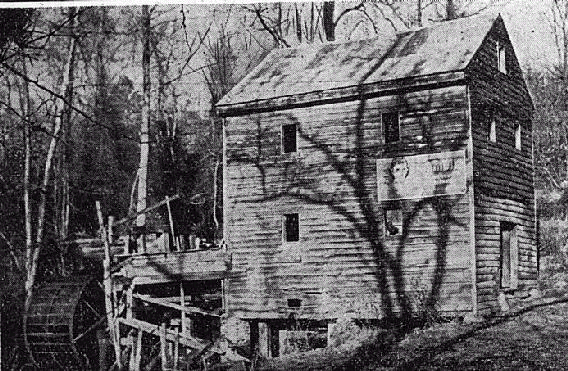|
The Texas Brigade, having earlier been sent to support General Jackson's divisions, as a feint to make the Federals beieve there was a planned push toward Washington, were returning with General Jackson's troops to the Richmond theater of operations. Early on the morning of June 27, 1862... while moving towards Cold Harbor/Gaines Mill area, the Confederates of General Jackson's command could hear the battle raging.
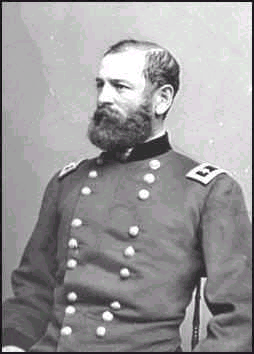 General Fitz John Porter General Fitz John Porter
|
Three Union divisions under Brig. Gen. Fitz John Porter had moved their line at Mechanicsville and had formed a stronger line that stretched over a series of hills, along the east bank of Boatswain's Swamp. Generals James Longstreet and A. P. Hill were sending their troops forward against this strongly entrenched position to try and dislodge the Union troops.
Upon entering the battlefield, General Jackson ordered General Richard Ewell's division to the left and General Whiting's division (which included the Texas Brigade and therefore the 18th Georgia Regiment of Volunteer Infantry)to the right, in company with the rest of General Jackson's corps.
Late in the day, General Whiting was ordered to support General Longstreet's attack on Union General Porter's left flank. General Hood's Texas Brigade was placed in the lead. At approximately 5:00 PM, skirmishers from the Texas Brigade reached a clear area where they could view the battle raging.
General Whitting's Division were deployed in front of Turkey Hill. This steep, heavily wooded hill was just across Boatswain's Swamp.
|
|
From his position, General Whiting was able to deduce that this hill he was facing was the highest point of the Union line. The Federals had stongly prepared its defenses with a line of abatis and had entrenched Colonel Berdan's First U.S. Sharpshooters near its base. Behind them, in support, were three brigades commanded by Union General George Morell, who had his men entrenched in two overlayed lines. The first was halfway up the hill, the second was near the top of the hill. At the crest of the hill were eighteen artillery pieces, under the command of Capt. William Weeden. Finally, in support and ready to route any attempt of a breakthrough, a battalion of Union cavalry commanded by General Philip St. George Cooke (Confederate General J.E.B. Stuart's father-in-law), was to General Fitz-John Porter's left, between him and the Chickahominy River. The Confederate approach to Boatswain's Swamp and Turkey Hill was both downwardly sloped and exposed.
General Robert E. Lee orderd General Whiting to have his men directly assault Turkey Hill. An assault that would be difficult at best, as it was first downhill and once committed...would be very exposed in approaching Boatswain's Swamp. This would prove to be the case until entering the wooded areas at the base of the steep Turkey Hill.
The obedient General Whiting prepared his division for the assault. Placing Colonel Evander Law's Brigade to the right of General Hood's Texas Brigade. General Hood deployed his brigade with Hampton's Legion on the left, the 18th Georgia to the right, with the First and Fifth Texas in the center. The Fourth Texas, General Hood's old regiment, was placed in reserve.
|
| 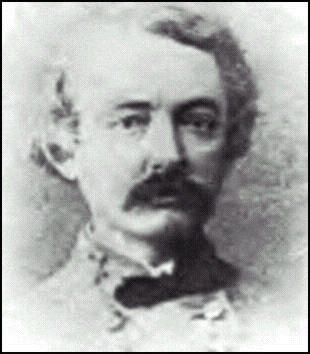 General William Henry Chase Whitting General William Henry Chase Whitting
|
|
Before the troops began their assault, Generals Lee and Whitting approached General Hood on horseback and General Lee asked, "Can you break his line?". The feisty Texan replied "I shall try". As General Lee turned to ride a way, he raised his hat in salute to General Hood and said, "May God be with you!"
General Hood rode forward to reconnoiter the situation from an open field just to the right of the 18th Georgia Regiment of Volunteer Infantry. He realized his men would be crossing 800 yards of exposed, rolling field, broken only by a wooded area on the closest bank of Boatswain's Swamp. He further realized that his men would be advancing under the same murderous artillery fire from the crest of Turkey Hill which had earlier stopped three attempts by General Longstreet's troops to take the hill.
|
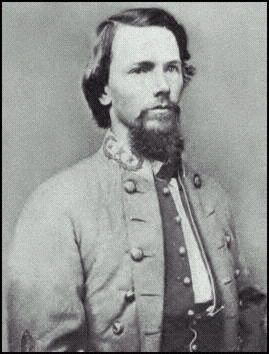 Colonel Evander Law Colonel Evander Law
|
There would be no Confederate artillery support, as the Union counterbattery fire had been very effective and had knocked out what Confederate artillery there was. General Hood wisely saw that there was a better way to approach the hill, from the right of Col. Evander Law's position. He also recognized it would be necessary to let the momentum of his attack push his men across the creek and not let them stop to return fire and relaod, as had the others before them. He knew that stopping to fire would break the momentum of the charge and allow the Federals to easily pick off his men.
General Hood stepped down from his mount and instructed the men of his Brigade not to open fire until they were given the order. He then gave the order to move forward with "quick step and determined spirit." The ever observant General, he realized there was a gap between Colonel Evander Law's and Brigadier General Pickett's men. General Hood quickly turned to his old regiment, the Fourth Texas, whom he had placed in reserve, and gave the order to Col. Marshall to bring his regiment by the right flank following him across the rear of Col. Law's Brigade. Along with the Fourth Texas, would come one or two companies of the 18th Georgia. Once in the clear, General Hood dressed the regiment and turned towards the enemy. Reiterating his earlier order not to fire until given the order, he ordered the troops forward and in so doing... personally led the advance.
|
|
As the Fourth Texas turned towards the enemy position on Turkey Hill, they immediately came under a murderous artillery barrage and musketry fire from Turkey Hill and at the same moment were subjected to enfilading fire from the Union troops across the Chickahominy River. The commander of the Fourth Texas was killed, however General Hood continued to order the men to be steady and hold their fire.
|
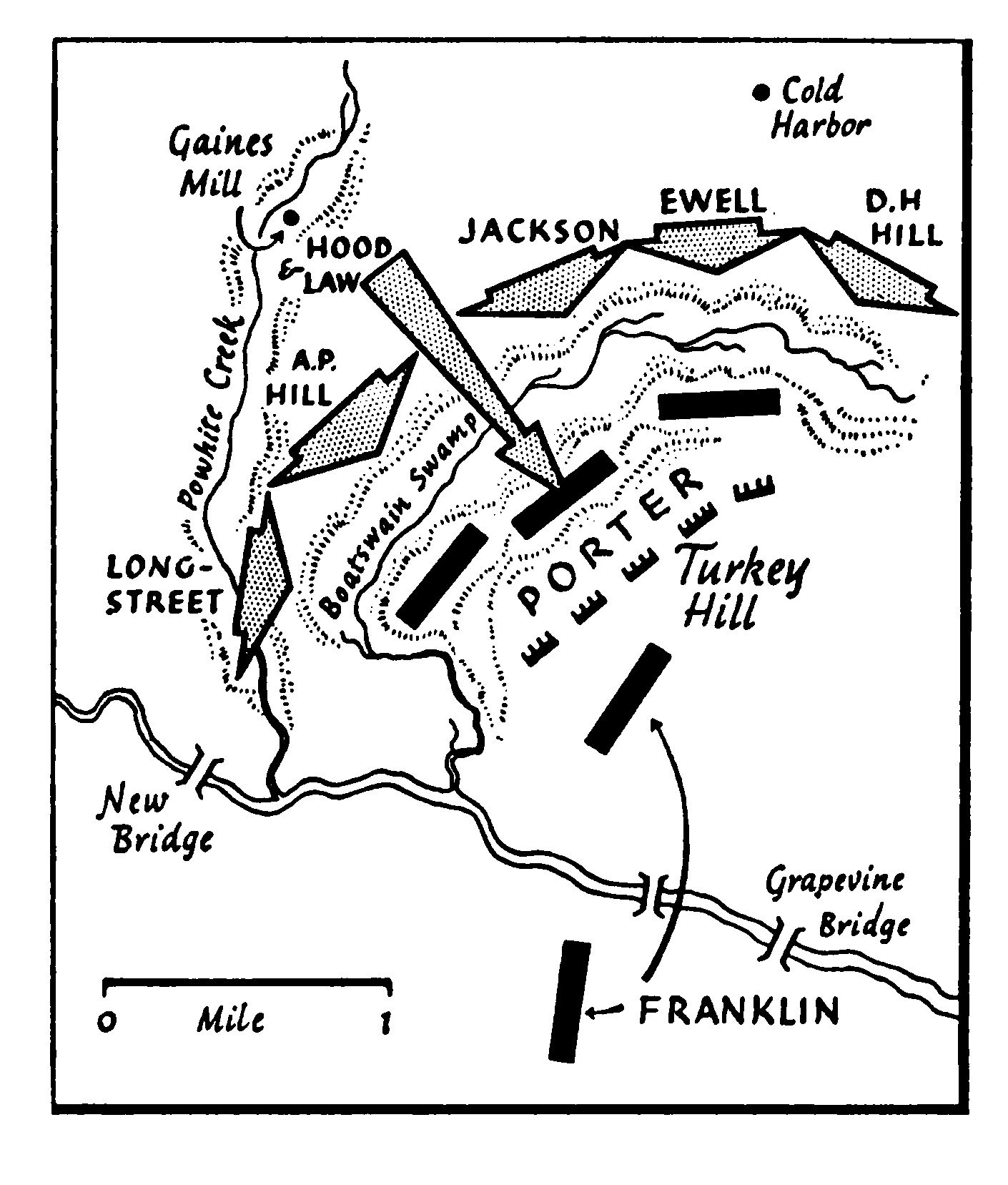 Turkey Hill Map showing the pathof the Texas Brigade Turkey Hill Map showing the pathof the Texas Brigade
|
As these brave Texans and Georgians continue their advance to within 300 yards of the creek, Berdan's Sharpshooters and Morell's infantry continued a brisk and accurate volley fire upon the advancing Confederates. The losses were great, the battle line continued to thin, the men reforming to close the gaps left by fallen comrades. They continued to hold their fire as they advanced at right shoulder lift. As they reached a low hill about 150 yards short of the creek, they observed a a line of Confederates from an earlier assault... holding tight to the ground and refusing to advance no matter the orders given by a young lieutenant, whose pleas were falling on deaf ears. Just then, Lieutenant Colonel Warwick, now in command of the Fourth Texas...save the presence of General Hood... seized the shaken group's battle flag and tried in vane to move them to join the advance. So terrified were they, these battle worn men would simply not budge. Lieutenant Colonel Warwick continues his advance, carrying the group's flag with him. The young lieutenant, realizing his efforts were futile, picked up a weapon from where his men lay and joined the advance of the Fourth Texas and men of the 18th Georgia. This brave young Lieutenant was killed during the advance, failing to reach the crest of Turkey Hill.
|
|
As the advancing Texans and Georgians came to the top of the low hill, near the bank of Boatswain's Swamp... Lt. Col. Warwick gave the order to halt and fire. General Hood immediately cancelled that order and gave the order to "Fix bayonets!" and to charge at the "double quick". Nearly 1000 of their fellow troops had already fallen, dead or wounded thus far in this charge. Sofar, not a shot had been fired by the charging Confederates. As they got to within 100 yards of the creek, the first line of sharpshooters began to leave their positions at the bottom of Turkey Hill and retreat to the entrenchments further up the hill.
|
|
The well disciplined Confederates still maintaining their Battle Line, continued their charge across the creek and up the steep bank. This caused even more of the sharpshooters to abandon their pits and retreat up the hill. The remaining Union troops of Martindale's Brigade, soon panicked and they too retreated up the hill. Seizing the opportunity, the advancing Confederates could no longer wait for their General to command them to fire and opened a punishing volley upon the fleeing Union troops. They did so at a close range and every shot counted, as each ball found flesh and bone of the panicked blue clad troops. As the panicked fleeing Federals ran by their second line of entrenchments, the panic became contagious and the troops of the second line gave way, joining their comrades in a general route. The routed Federals turned and sent a few scattered volleys into the ranks of the oncoming Confederates. One bullet, finding its mark, fell the brave Lt. Col. Warwick, mortally wounding him... still carrying the battle flag he had taken from the frightened Confederates he had tried to encourage further down the hill.
|
|
As General Hood led the Fourth Texas and the accompanying elements of the 18th Georgia to the top of Turkey Hill, he sent word for the remaining regiments of the Texas Brigade to quickly exploit the breach. It was not long after, the First and Fifth Texas and Hampton's Legion were on the plateau above Turkey Hill. Union General Porter's left flank was crumbling quickly as Evander Law's and General Pickett's Brigades continued to widen the breakthrough.
General Hood orderd the Fourth Texas and now, the remainder of the 18th Georgia, to halt in an orchard on the hilltop. In the open, these men were immediately taken under fire with canister... from Union artillery on their left. General Hood swung the two regiments around to face the guns and ordered a charge at the guns. As they turned, they fired a volley into the horses and men manning the Union cannon, and then with General Hood leading....charged!The weight of the charge by the combined regiments resulted in the capture of fourteen of the eighteen artillery pieces and a full regiment of Pennsylvania troops threw down their weapons in surrender.
The Texas Brigade then continued to press after the fleeing Union infantry. The Fifth Texas, while advancing across the plateau toward the Chickahominy River, came under fire from the rear. Turning about, the Fifth Texas faced the Fourth New Jersey Infantry, who had been bypassed while the Confederates made their dashing breakthrough. Realizing the futility of their situation, the soldiers from New Jersey saw that they were surrounded and lowered their flag in surrender.
|
|
Meanwhile, the rumbling of General Philip St.George Cooke's Fifth U.S. Cavalry could be heard by the Texans and Georgians, as they were charging them to prevent the capture of more Federal artillery. As he had done earlier, General Hood swung the two regiments about to face the enemy threat. Once the cavalry was within forty yards, he ordered the men of the Fourth Texas and 18th Georgia to fire a volley into the charging Federal cavalry. The Confederate enfields proved to be devastating as they did their work and unseated nearly 150 of the 250 Union horsemen. This stopped the attack and proved to be the last action by the Federals for the remainder of the day.
As the battle ended and toll was taken of their losses, the Fourth Texas had suffered the most during the charge at Turkey Hill; with 44 killed, 208 wounded, and 1 missing. This included half of all the enlisted men and everyone of the field-grade officers were casualties. They had lost their regimental commander, Colonel Marshall and his successor, Lt. Col. Warwick, both killed during the assault on Turkey Hill. Amazingly though, General Hood, who was at the front of the Fourth Texas during the entire action, was unscathed. In total, the losses for the Texas Brigade were 571: 86 killed, 481 wounded, and four missing.
|
| 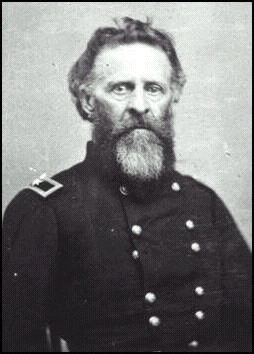 General Philip St. George Cooke General Philip St. George Cooke
|
|
The brave men of the Texas Brigade, all of whom had some part in spearheading the final assault that broke the back of the Union lines, giving General Lee his first victory, and earning them the respect of the whole Army of Northern Virginia, were men of the 1st, 4th, 5th Texas, Hampton's Legion and the 18th Georgia Regiment of Volunteer Infantry.
Later, when General Thomas (Stonewall)Jackson inspected the abandoned Federal positions on Turkey Hill, he remarked, "The men that carried this position were soldiers indeed!"
An article in the Richmond Whig, said of the 18th Georgia Regiments part in the action against the Union positions at Turkey Hill; "The regiment was under fire for about three hours, and lost one hundred and forty-eight in killed and wounded. Two officers killed and six wounded. Carried into action five hundred and seven men. Every officer and man acted with great gallantry and coolness."
General Lee, in a letter to Confederate President Davis wrote, "Profoundly grateful to Almighty God" the Confederate's had their first real victory. Twenty two guns and more than 2000 prisoners were captured. However, the Confederates had lost 8500 men in total. The Union army of Fitz John Porter had lost 6837 killed, wounded and captured.
The army of General McClellan was beaten back, but not done in. General Lee realized this and wrote to President Davis, "We sleep on the field and shall continue the contest in the morning." However, as morning came General Lee would learn that Union General Fitz John Porter had withdrawn, back towards White House, Virginia. The Confederates would have a respite as their commander tried to determine his enemy's next move.
The 18th Georgia regiment of Volunteer Infantry suffered 16 killed, 126 wounded, and 3 missing. One of the wounded was my Great Great Grandfather, Pvt. George R. Smith. Records from the National Archives show him appearing on a "list of casualties, of the 18th Georgia Regiment, in the engagement at Cold harbor, Va., June 27, 1862. REMARKS: Severely wounded in leg." This file was found in Series 1, Vol.11, part 2, page 568. Other records show he was admitted to General Hospital, Howards Grove, Richmond, Virginia on June 29, 1862. He received a 40 day furlough (convalesence) on July 12, 1862. He travelled to Cartersville, Ga. and returned to his regiment on August 22, 1862, just as they were marching towards Thoroughfare Gap, on their way to relieve General Thomas (Stonewall) Jackson's troops at the Battle of 2nd Manassas.
Hence, the Legend continued.
My Home Page
| |


